总结:
1、BST两个相关问题解决点
(1)与二分查找绑定。
- BST的遍历是二分查找(4.1节 BST的二分查找)
- ***** 删除BST一个节点 (4.2.3 )*****
(2)中序遍历相关。通过中序遍历二叉搜索树得到的关键码序列是一个递增序列。这是二叉搜索树的一个重要性质。如果说我们需要降序,则此时就转换下先遍历right再left就可以了。
- BST的最小绝对值差
- BST二叉排序变累加树
|
1 2 3 4 5 6 7 8 9 |
private void inOrder(TreeNode root, List<Integer> list){ if(root == null){ return ; } inOrder(root.left,list); list.add(root.val); inOrder(root.right,list); } |
(3) 获取中序遍历的左右两个邻接点。
- 中序遍历序列的下一个节点,即右临界点
|
1 2 3 4 5 6 7 |
public int successor(TreeNode root) { root = root.right; while (root.left != null) { root = root.left; } return root; } |
- 中序遍历序列的前一个节点,即左临界点
|
1 2 3 4 5 |
public int predecessor(TreeNode root) { root = root.left; while (root.right != null) root = root.right; return root; } |
2、构建二查数。中序+先序;中序+后序。
3、 树转链表6.1单链表。6.2 双链表
4、利用树的路径计算 7.1 (二进制、或者十进制)
树的路径。3.9:先减后加/先进栈后出栈
5、通过遍历获取一个数组
6、层次遍历,需要借助于 队列。
Queue<TreeNode> queue = new LinkedList<TreeNode>();
7、树的路径。(3.9节)
8、判断两棵树是不是一样。
1 概念
1、完全二叉树 和 满二叉树。
(1)完全二叉树
一棵深度为k的有n个结点的二叉树,对树中的结点按从上至下、从左到右的顺序进行编号,如果编号为i(1≤i≤n)的结点与满二叉树中编号为i的结点在二叉树中的位置相同,则这棵二叉树称为完全二叉树。—百科。
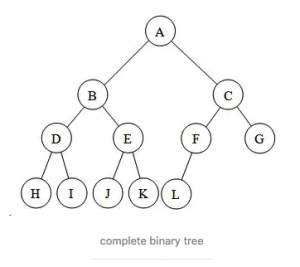
(2)满二叉树
二叉树除了叶结点外所有节点都有两个子节点。
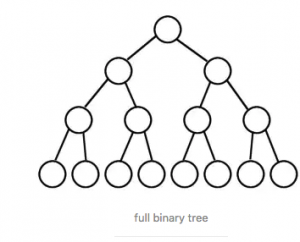
(3)比较

- 满二叉树,每个非叶子节点必须有两个子节点。
- 完全二叉树。分层遍历,中间不能有null节点。
2、 二叉查找树BST。
二叉查找树(Binary Search Tree),(又:二叉搜索树,二叉排序树)它或者是一棵空树,或者是具有下列性质的二叉树: 若
- 若左子树不空,则左子树上所有结点的值均小于它的根结点的值;
- 若右子树不空,则右子树上所有结点的值均大于或等于它的根结点的值;
BST树中没有重复的节点。
3、平衡二叉树 -AVL 树
平衡二叉树的提出就是为了保证树不至于太倾斜,尽量保证两边平衡。因此它的定义如下:
平衡二叉树要么是一棵空树
要么保证左右子树的高度之差不大于 1
子树也必须是一颗平衡二叉树
2 构造树
先序和后序是不能确定一棵树。先序和中序、中序和后序可以确定一棵树。
2.1 树的存储结构
1、链表
|
1 2 3 4 5 6 7 8 9 |
class TreeNode { int val; TreeNode left; TreeNode right; TreeNode(int val) { this.val = val; } } |
2、数组
分层存储,如下:[236,104,701,null,227,null,911]
2.2 根据前序和中序构造树
根据一棵树的前序遍历与中序遍历构造二叉树。
注意:
你可以假设树中没有重复的元素。
例如,给出
|
1 2 |
前序遍历 preorder = [3,9,20,15,7] 中序遍历 inorder = [9,3,15,20,7] |
链接:https://leetcode-cn.com/problems/construct-binary-tree-from-preorder-and-inorder-traversal/
算法:
- Step1 前序第一个节点A为根节点,在中序中A的左边子数组的节点就是A的左子树,右子数组就是右子树的节点。
- Step2 根据A节点,把中序数组划分为左右子树之后,对于一个左子树或右子树,前序数组和后序数组大小是一样的。
|
1 2 3 4 5 6 7 8 9 10 11 12 13 14 15 16 17 18 19 20 21 22 23 24 25 26 27 28 29 30 31 32 33 34 35 36 37 38 39 40 41 42 43 44 45 46 47 48 49 50 51 52 53 54 55 56 57 |
public class CreatTreeBasePreAndCenter { // 保存中序位置 private HashMap<Integer, Integer> dic = new HashMap(); public TreeNode buildTree(int[] preorder, int[] inorder) { for (int i = 0; i < inorder.length; i++) { dic.put(inorder[i], i); } return build(preorder,inorder,0,preorder.length-1,0,inorder.length-1); } private TreeNode build(int[] preorder, int[] inorder, int leftPre, int rightPre,int orderPre, int orderRight) { if (leftPre < 0 || leftPre > rightPre) { return null; } if (leftPre == rightPre) { return new TreeNode(preorder[leftPre]); } TreeNode treeNode = new TreeNode(preorder[leftPre]); // 在中序的位置 int rootIndex = dic.get(preorder[leftPre]); // 左子树的节点个数 int leftCount = rootIndex - orderPre; // 根据中序数组划分为左右子树之后,对于一个左子树或右子树,前序数组和后序数组大小是一样的。 treeNode.left = build(preorder, inorder, leftPre+1, leftPre+leftCount, orderPre, rootIndex - 1); treeNode.right = build(preorder, inorder, leftPre+leftCount + 1, rightPre, rootIndex + 1, orderRight); return treeNode; } class TreeNode { int val; TreeNode left; TreeNode right; TreeNode(int val) { this.val = val; } } public static void main(String[] args){ int[] porder = new int[]{1,2,3}; int[] inorder = new int[]{3,2,1}; CreatTreeBasePreAndCenter creatTreeBasePreAndCenter = new CreatTreeBasePreAndCenter(); TreeNode root = creatTreeBasePreAndCenter.buildTree(porder,inorder); } } |
2.2 根据后序和中序构造树
根据一棵树的中序遍历与后序遍历构造二叉树。
注意:
你可以假设树中没有重复的元素。
例如,给出
|
1 2 |
中序遍历 inorder = [9,3,15,20,7] 后序遍历 postorder = [9,15,7,20,3] |
https://leetcode-cn.com/problems/construct-binary-tree-from-inorder-and-postorder-traversal/
算法:
与前序+中序的不同点有两个地方,参考如下build方法
- 从postOrder[]数组末尾获取根节点
- 递归时,起始地址不同
|
1 2 3 4 5 6 7 8 9 10 11 12 13 14 15 16 17 18 19 20 21 22 23 24 25 26 27 28 29 30 31 32 33 34 35 36 37 38 39 40 41 42 43 44 45 46 47 48 49 50 51 52 53 54 55 56 57 58 |
public class CreatTreeBasePreAndCenter { private HashMap<Integer, Integer> dic = new HashMap(); public TreeNode buildTree(int[] postOrder, int[] inOrder) { for (int i = 0; i < inOrder.length; i++) { dic.put(inOrder[i], i); } return build(postOrder,inOrder,0,postOrder.length-1,0,inOrder.length-1); } private TreeNode build(int[] postOrder, int[] inOrder, int postLeft, int postRight, int inLeft, int inRight) { if (postLeft < 0 || postLeft > postRight) { return null; } if (postLeft == postRight) { return new TreeNode(postOrder[postLeft]); } // 不同点1: 根节点不同 TreeNode treeNode = new TreeNode(postOrder[postRight]); // 在中序的位置 int rootIndex = dic.get(postOrder[postRight]); // 左子树的节点个数 int leftCount = rootIndex - inLeft; // 不同点2:起始地址不同 treeNode.left = build(postOrder, inOrder, postLeft, postLeft+leftCount-1, inLeft, rootIndex - 1); treeNode.right = build(postOrder, inOrder, postLeft+leftCount , postRight-1, rootIndex + 1, inRight); return treeNode; } class TreeNode { int val; TreeNode left; TreeNode right; TreeNode(int val) { this.val = val; } } public static void main(String[] args){ int[] inorder = new int[]{9,3,15,20,7}; int[] porder = new int[]{9,15,7,20,3}; CreatTreeBasePreAndCenter creatTreeBasePreAndCenter = new CreatTreeBasePreAndCenter(); TreeNode root = creatTreeBasePreAndCenter.buildTree(porder,inorder); System.out.printf(root.toString()); } } |
3 树的遍历
3.1 四种遍历介绍
前序遍历:根结点 —> 左子树 —> 右子树
中序遍历:左子树—> 根结点 —> 右子树
后序遍历:左子树 —> 右子树 —> 根结点
层次遍历:只需按层次遍历即可
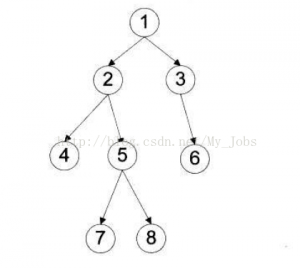
前序遍历:1 2 4 5 7 8 3 6
中序遍历:4 2 7 5 8 1 3 6
后序遍历:4 7 8 5 2 6 3 1
层次遍历:1 2 3 4 5 6 7 8
代码如下:
|
1 2 3 4 5 6 7 8 9 10 11 12 13 14 15 16 17 18 19 20 21 22 23 24 25 26 27 28 29 30 31 32 33 34 35 36 37 38 39 40 41 42 43 44 45 46 47 48 49 50 51 52 53 54 55 56 57 58 59 60 61 62 63 64 65 66 67 68 69 70 71 72 73 74 75 76 77 78 79 80 81 82 83 84 85 |
public class TreeSearch { // 前序遍历 public static void preSea(TreeNode root){ if(root == null){ return; } System.out.printf(root.val+"->"); preSea(root.left); preSea(root.right); } // 前序遍历 public static void midSea(TreeNode root){ if(root == null){ return; } midSea(root.left); System.out.printf(root.val+"->"); midSea(root.right); } // 后序遍历 public static void postSea(TreeNode root){ if(root == null){ return; } postSea(root.left); postSea(root.right); System.out.printf(root.val+"->"); } // 分层遍历 public static void laySea(TreeNode root){ if(root == null){ return; } Queue<TreeNode> queue = new LinkedList<TreeNode>(); queue.add(root); while (!queue.isEmpty()){ TreeNode node = queue.poll(); System.out.printf(node.val+"->"); if(node.left != null){ queue.add(node.left); } if(node.right != null){ queue.add(node.right); } } } public static void main(String[] args){ TreeNode n1 =new TreeNode(1); TreeNode n2 =new TreeNode(2); TreeNode n3 =new TreeNode(3); TreeNode n4 =new TreeNode(4); TreeNode n5 =new TreeNode(5); TreeNode n6 =new TreeNode(6); TreeNode n7 =new TreeNode(7); TreeNode n8 =new TreeNode(8); n1.left=n2; n1.right=n3; n2.left=n4;n2.right=n5; n5.left=n7;n5.right=n8; n3.right=n6; System.out.println("pre:"); preSea(n1); System.out.println(""); System.out.println("mid:"); midSea(n1); System.out.println(""); System.out.println("post:"); postSea(n1); System.out.println(""); System.out.println("lay:"); laySea(n1); } } |
3.2 分层遍历
3.2.1 从上到下打印二叉树 II(每一层是输出一个组数组)
从上到下按层打印二叉树,同一层的节点按从左到右的顺序打印,每一层打印到一行。
例如:
给定二叉树: [3,9,20,null,null,15,7],
|
1 2 3 4 5 |
3 / \ 9 20 / \ 15 7 |
返回结果
|
1 2 3 4 5 |
[ [3], [9,20], [15,7] ] |
链接:
- 题目1 https://leetcode-cn.com/problems/cong-shang-dao-xia-da-yin-er-cha-shu-ii-lcof/
- 题目2 https://leetcode-cn.com/problems/binary-tree-level-order-traversal/submissions/
算法:
- 假设同层有A/B两个节点,那么下一层,如何保证A的子节点和B的子节点在一个数组? 在queue队列中保存一个node数组,是没层的所有节点。
|
1 2 3 4 5 6 7 8 9 10 11 12 13 14 15 16 17 18 19 20 21 22 23 24 25 26 27 28 29 30 31 32 33 34 35 36 37 38 39 40 41 42 |
// 假设同层有A/B两个节点,那么下一层,如何保证A的子节点和B的子节点在一个数组? // 在queue队列中保存一个node数组,是没层的所有节点 class Solution { public List<List<Integer>> levelOrder(TreeNode root) { List<List<Integer>> result = new ArrayList<List<Integer>>(); if(root == null){ return result; } Queue<List<TreeNode>> queue = new LinkedList<List<TreeNode>>(); List<TreeNode> rootList = new ArrayList<TreeNode>(); rootList.add(root); queue.add(rootList); List<Integer> first = new ArrayList(); first.add(root.val); result.add(first); while (!queue.isEmpty()){ List<TreeNode> nodeList = queue.poll(); List<Integer> valList = new ArrayList(); List<TreeNode> sonList = new ArrayList<TreeNode>(); for(TreeNode node: nodeList){ if(node.left != null){ valList.add(node.left.val); sonList.add(node.left); } if(node.right != null){ valList.add(node.right.val); sonList.add(node.right); } } if(valList.size()>0){ result.add(valList); queue.add(sonList); } } return result; } } |
3.2.2 二叉树的层平均值
给定一个非空二叉树, 返回一个由每层节点平均值组成的数组。
链接:https://leetcode-cn.com/problems/average-of-levels-in-binary-tree/
算法:在3.2.1的结果基础上,计算平均值就可以
|
1 2 3 4 5 6 7 8 9 10 11 12 13 14 15 16 17 |
public List<Double> averageOfLevels(TreeNode root) { List<Double> result = new ArrayList(); if(root == null){ return result; } // 3.2.1的结果 List<List<Integer>> levelNodeList = levelOrder(root); for(int i=0;i<levelNodeList.size();i++){ double sum =0; for(Integer node : levelNodeList.get(i)){ sum += node; } result.add(sum/levelNodeList.get(i).size()); } return result; } |
3.3 前序遍历
3.3.1 二叉树前序遍历
给定一个二叉树,返回它的 前序 遍历。
输出
|
1 2 3 4 5 6 7 8 |
输入: [1,null,2,3] 1 \ 2 / 3 输出: [1,2,3] |
链接:https://leetcode-cn.com/problems/binary-tree-preorder-traversal/
算法
|
1 2 3 4 5 6 7 8 9 10 11 12 13 14 15 16 17 18 19 |
class Solution { public List<Integer> preorderTraversal(TreeNode root) { List<Integer> result = new ArrayList<Integer>(); if(root==null){ return result; } pre(root,result); return result; } private void pre(TreeNode root, List<Integer> result ){ if(root == null){ return; } result.add(root.val); pre(root.left,result); pre(root.right,result); } } |
3.3.2 N叉数前序遍历
链接:https://leetcode-cn.com/problems/n-ary-tree-preorder-traversal/
|
1 2 3 4 5 6 7 8 9 10 11 12 13 14 15 16 17 18 19 20 21 22 23 24 25 26 27 28 29 30 31 32 33 34 35 36 37 38 39 40 |
/* // Definition for a Node. class Node { public int val; public List<Node> children; public Node() {} public Node(int _val) { val = _val; } public Node(int _val, List<Node> _children) { val = _val; children = _children; } }; */ class Solution { public List<Integer> preorder(Node root) { List<Integer> result = new ArrayList<Integer>(); if(root == null){ return result; } pre(root,result); return result; } private void pre(Node root, List<Integer> result){ if(root == null){ return ; } result.add(root.val); for(Node node: root.children){ pre(node,result); } } } |
3.4 后序遍历
同前序遍历
二叉树: https://leetcode-cn.com/problems/binary-tree-postorder-traversal/submissions/
N叉树:https://leetcode-cn.com/problems/n-ary-tree-postorder-traversal/submissions/
3.5 中序遍历
二叉树: https://leetcode-cn.com/problems/binary-tree-inorder-traversal/submissions/
3.6 判断是为相同的树
3.6.1 判断是否相同树
给定两个二叉树,编写一个函数来检验它们是否相同。
如果两个树在结构上相同,并且节点具有相同的值,则认为它们是相同的。
链接:https://leetcode-cn.com/problems/same-tree/
算法:遍历一遍,如果每个节点相同就是相同的树。
|
1 2 3 4 5 6 7 8 9 10 11 12 13 14 15 16 17 18 |
class Solution { public boolean isSameTree(TreeNode p, TreeNode q) { return preOrder(p,q); } private boolean preOrder(TreeNode p, TreeNode q){ if((p==null && q!=null) || (q==null && p!=null)){ return false; } if(p==null && q==null){ return true; } if(p.val != q.val){ return false; } return preOrder(p.left,q.left) && preOrder(p.right,q.right); } } |
3.6.2 判断是否子树
给定两个非空二叉树 s 和 t,检验 s 中是否包含和 t 具有相同结构和节点值的子树。s 的一个子树包括 s 的一个节点和这个节点的所有子孙。s 也可以看做它自身的一棵子树。
s为:
|
1 2 3 4 5 |
3 / \ 4 5 / \ 1 2 |
t为
|
1 2 3 |
4 / \ 1 2 |
输出为:true
来源:力扣(LeetCode)
链接:https://leetcode-cn.com/problems/subtree-of-another-tree
算法:遍历s树的每个节点,判断s是否和t为同一个树
|
1 2 3 4 5 6 7 8 9 10 11 12 13 14 15 16 17 18 19 20 21 22 23 24 25 26 27 28 29 30 31 |
class Solution { public boolean isSubtree(TreeNode s, TreeNode t) { // 如果s是空节点。由题意 t不为空 if(s==null){ return false; } boolean isNodeSame = isSameTree(s,t); if(isNodeSame){ return true; } boolean isLeft = isSubtree(s.left,t) ; if(isLeft){ return true; } boolean isRight = isSubtree(s.right,t); return isRight; } public boolean isSameTree(TreeNode p, TreeNode q) { if (p == null && q == null) { return true; } else if (p == null || q == null) { return false; } else if (p.val != q.val) { return false; } else { return isSameTree(p.left, q.left) && isSameTree(p.right, q.right); } } } |
3.7 对称二叉树
给定一个二叉树,检查它是否是镜像对称的。
例如,二叉树 [1,2,2,3,4,4,3] 是对称的。
|
1 2 3 4 5 |
1 / \ 2 2 / \ / \ 3 4 4 3 |
链接:https://leetcode-cn.com/problems/symmetric-tree/
算法:拆成2个树,判断是否为两个树镜像树。
- 判断两个树是否为镜像树,可以参考3.6树相等校验逻辑。
|
1 2 3 |
// 与判断相同树的区别点 isMirrorTree(p.left,q.right); isMirrorTree(p.right,q.left); |
算法
|
1 2 3 4 5 6 7 8 9 10 11 12 13 14 15 16 17 18 19 20 21 22 23 24 |
class Solution { // 思想:拆成2个树,判断是否为两个树镜像树 public boolean isSymmetric(TreeNode root) { if(root == null){ return true; } return isMirrorTree(root.left,root.right); } public boolean isMirrorTree(TreeNode p, TreeNode q) { if((p==null && q!=null) || (q==null && p!=null)){ return false; } if(p==null && q==null){ return true; } if(p.val != q.val){ return false; } // 与判断相同树的区别点 return isMirrorTree(p.left,q.right) && isMirrorTree(p.right,q.left); } } |
3.8 完全二叉树的节点个数
给出一个完全二叉树,求出该树的节点个数。
链接:https://leetcode-cn.com/problems/count-complete-tree-nodes/
算法:通过前序遍历和全局变量
|
1 2 3 4 5 6 7 8 9 10 11 12 13 14 15 16 17 18 19 |
class Solution { int sum = 0; public int countNodes(TreeNode root) { if(root == null){ return 0; } preOrder(root); return sum; } private void preOrder(TreeNode root){ if(root == null){ return; } sum++; preOrder(root.left); preOrder(root.right); } } |
3.9 树的路径
3.9.1 树的总路径
给定一个二叉树和一个目标和,判断该树中是否存在根节点到叶子节点的路径,这条路径上所有节点值相加等于目标和。
|
1 2 3 4 5 6 7 |
5 / \ 4 8 / / \ 11 13 4 / \ \ 7 2 1 |
来源:力扣(LeetCode)
链接: https://leetcode-cn.com/problems/path-sum/
算法:
- 找到叶子节点(root.left == null && root.right==null) , 判断是否满足路径条件。
- 对于全局sum的值,每次扫描非叶子节点,先执行add,如果改节点的叶子节点没有找到满足的路径,再执行 sub操作。
|
1 2 3 4 5 6 7 8 9 10 11 12 13 14 15 16 17 18 19 20 21 22 23 24 25 26 27 28 29 30 31 32 33 34 35 36 37 38 39 40 41 42 43 44 |
class Solution { int sum = 0; boolean result = false; public boolean hasPathSum(TreeNode root, int target) { if(root == null){ return false; } preOrder(root,target); return result; } // 算法: // 找到叶子节点(root.left == null && root.right==null) // 判断是否满足条件。 private void preOrder(TreeNode root,int target){ // 如果找到了就不遍历了 if(result){ return; } // 找到叶子节点 if(root.left == null && root.right==null){ // 判断累加值 int temp = sum + root.val; if(temp == target){ result = true; } // 返回 return; } // 执行add操作 sum += root.val; if(root.left!=null){ preOrder(root.left,target); } if(root.right!=null){ preOrder(root.right,target); } // 恢复操作 if(!result){ sum -= root.val; } } } |
3.9.2 路径总和 III
给定一个二叉树和一个目标和,找到所有从根节点到叶子节点路径总和等于给定目标和的路径。
示例:
给定如下二叉树,以及目标和 sum = 22,
|
1 2 3 4 5 6 7 |
5 / \ 4 8 / / \ 11 13 4 / \ / \ 7 2 5 1 |
输出:
|
1 2 3 4 |
[ [5,4,11,2], [5,8,4,5] ] |
链接:https://leetcode-cn.com/problems/path-sum-ii/
算法:相对于3.9.1需要新增一个stack,而且需要输出所有的路径。
|
1 2 3 4 5 6 7 8 9 10 11 12 13 14 15 16 17 18 19 20 21 22 23 24 25 26 27 28 29 30 31 32 33 34 35 36 37 38 39 40 41 42 43 44 45 46 47 48 49 50 51 52 53 |
class Solution { int sum = 0; List<List<Integer>> result = new ArrayList<List<Integer>>(); Stack<TreeNode> stack = new Stack<TreeNode>(); public List<List<Integer>> pathSum(TreeNode root, int target) { if(root == null){ return result; } preOrder(root,target); return result; } // 算法: // 找到叶子节点(root.left == null && root.right==null) // 判断是否满足 private void preOrder(TreeNode root,int target){ // 找到叶子节点 if(root.left == null && root.right==null){ // 判断累加值 int temp = sum + root.val; if(temp == target){ record(root); } // 返回 return; } sum += root.val; stack.push(root); if(root.left!=null){ preOrder(root.left,target); } if(root.right!=null){ preOrder(root.right,target); } sum -= root.val; stack.pop(); } private void record(TreeNode root){ List<Integer> valueList = new ArrayList<Integer>(); for(int i=0;i<stack.size();i++){ valueList.add(stack.get(i).val); } valueList.add(root.val); result.add(valueList); } } |
3.9.3 求根到叶子节点数字(0-9)之和
给定一个二叉树,它的每个结点都存放一个 0-9 的数字,每条从根到叶子节点的路径都代表一个数字。
|
1 2 3 4 5 |
输入: [1,2,3] 1 / \ 2 3 输出: 25 |
链接:https://leetcode-cn.com/problems/sum-root-to-leaf-numbers/
算法:获取树的路径,然后计算。
|
1 2 3 4 5 6 7 8 9 10 11 12 13 14 15 16 17 18 19 20 21 22 23 24 25 26 27 28 29 30 31 32 33 34 35 36 37 38 39 40 41 42 43 44 45 46 47 48 49 50 51 |
class Solution { List<String> allPath = new ArrayList<String>(); Stack<TreeNode> nodeStack = new Stack<TreeNode>(); public int sumNumbers(TreeNode root) { if (root == null) { return 0; } // 获取树的路径 preOrder(root); // 累加数 int sum = 0; for (String path : allPath) { sum += Integer.parseInt(path); } return sum; } private void preOrder(TreeNode node) { if (node.left == null && node.right == null) { output(node); return; } // 进栈 nodeStack.push(node); // 遍历 if (node.left != null) { preOrder(node.left); } if (node.right != null) { preOrder(node.right); } // 出栈 nodeStack.pop(); } // 数字字符传 private void output(TreeNode leaf) { StringBuilder path = new StringBuilder(); for (int i = 0; i < nodeStack.size(); i++) { path.append(nodeStack.get(i).val + ""); } path.append(leaf.val + ""); allPath.add(path.toString()); } } |
3.9.4 从根到叶的二进制数之和
给出一棵二叉树,其上每个结点的值都是 0 或 1 。每一条从根到叶的路径都代表一个从最高有效位开始的二进制数。
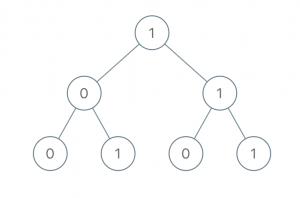
|
1 2 3 |
输入:[1,0,1,0,1,0,1] 输出:22 解释:(100) + (101) + (110) + (111) = 4 + 5 + 6 + 7 = 22 |
链接:https://leetcode-cn.com/problems/sum-of-root-to-leaf-binary-numbers/
算法:和7.1十进制比较,只是多了一个将二进制字符串转成10机制的函数。
|
1 2 3 4 5 6 7 8 9 10 11 12 13 14 15 16 17 18 19 20 21 22 23 24 25 |
public int sumRootToLeaf(TreeNode root) { if (root == null) { return 0; } // 获取树的路径 preOrder(root); // 累加数 int sum = 0; for (String path : allPath) { // 转成十进制 sum += transfer(path); } return sum; } // 十进制 private int transfer(String path){ int value =0 ; int base = 1; for(int i=path.length()-1;i>=0;i--){ value += Integer.parseInt(path.charAt(i)+"")*base; base = base * 2; } return value; } |
3.10 二叉搜索树的最近公共祖先
给定一个二叉搜索树, 找到该树中两个指定节点的最近公共祖先。
例如,给定如下二叉搜索树: root = [6,2,8,0,4,7,9,null,null,3,5]
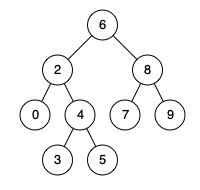
来源:力扣(LeetCode)
链接:https://leetcode-cn.com/problems/lowest-common-ancestor-of-a-binary-search-tree/
算法:后序遍历;如果左右子树同时返回了非空节点,那么这个根节点就是所找的根节点。
|
1 2 3 4 5 6 7 8 9 10 11 12 13 14 15 16 17 18 19 20 21 22 23 24 25 26 |
class Solution { public TreeNode lowestCommonAncestor(TreeNode root, TreeNode p, TreeNode q) { return pre(root,p,q); } private TreeNode pre(TreeNode root, TreeNode p, TreeNode q){ if(root == null){ return null; } if(root==p){ return p; } if(root == q){ return q; } TreeNode left = pre(root.left,p,q); TreeNode right = pre(root.right,p,q); if(left !=null && right !=null){ return root; }else if(left !=null){ return left; }else{ return right; } } } |
4 BST树
4.1 BST查找某一个节点
定二叉搜索树(BST)的根节点和一个值。 你需要在BST中找到节点值等于给定值的节点。 返回以该节点为根的子树。 如果节点不存在,则返回 NULL。
输入:
|
1 2 3 4 5 6 7 8 9 |
给定二叉搜索树: 4 / \ 2 7 / \ 1 3 和值: 2 |
输出:
|
1 2 3 |
2 / \ 1 3 |
链接 https://leetcode-cn.com/problems/search-in-a-binary-search-tree/
算法:利用BST的属性(right>root>left),进行二分查找。
|
1 2 3 4 5 6 7 8 9 10 11 12 13 14 15 16 17 18 19 20 21 22 23 24 |
class Solution { public TreeNode searchBST(TreeNode root, int val) { if(root==null){ return null; } return inorder(root,val); } private TreeNode inorder(TreeNode root, int val ){ if(root == null){ return null; } if(root.val == val){ return root; } // 利用BST的属性,进行二分查找 if(root.val < val){ return inorder(root.right,val); }else{ return inorder(root.left,val); } } } |
4.2 BST与中序遍历
通过中序遍历二叉搜索树得到的关键码序列是一个递增序列。这是二叉搜索树的一个重要性质。如果说我们需要降序,则此时就转换下先遍历right再left就可以了。
|
1 2 3 4 5 6 7 8 9 |
private void inOrder(TreeNode root, List<Integer> list){ if(root == null){ return ; } inOrder(root.left,list); list.add(root.val); inOrder(root.right,list); } |
4.2.1 BST二叉排序树的最小绝对值差
给你一棵所有节点为非负值的二叉搜索树,请你计算树中任意两节点的差的绝对值的最小值。
https://leetcode-cn.com/problems/minimum-absolute-difference-in-bst/
方案1 中序遍历
思想: 通过中序遍历二叉搜索树得到的关键码序列是一个递增序列,简化了方案2获取有序数组的步骤。
|
1 2 3 4 5 6 7 8 9 10 11 12 13 14 15 16 17 18 19 20 21 22 23 24 25 26 27 28 29 |
class Solution { private int min = Integer.MAX_VALUE; public int getMinimumDifference(TreeNode root) { if(root == null){ return 0; } // 中序遍历生成数组 List<Integer> list = new ArrayList<Integer>(); inOrderSearch(root,list); // 遍历数组 int min = Integer.MAX_VALUE; for(int i=1; i<list.size();i++){ min = Math.min(min,Math.abs(list.get(i)-list.get(i-1))); } return min; } private void inOrderSearch(TreeNode root, List<Integer> result){ if(root == null){ return; } inOrderSearch(root.left,result); result.add(root.val); inOrderSearch(root.right,result); } } |
方案2: 转换成数组&&排序
- STEP1 生成遍历数组
- STEP2 排序
- STEP3 扫描一次数组可以获取到最小值。
|
1 2 3 4 5 6 7 8 9 10 11 12 13 14 15 16 17 18 19 20 21 22 23 24 25 26 27 28 29 30 |
class Solution { public int getMinimumDifference(TreeNode root) { if(root == null){ return 0; } // 前序遍历生成数组 List<Integer> list = new ArrayList<Integer>(); preSearch(root,list); // 排序 Collections.sort(list); // 遍历数组 int min = Integer.MAX_VALUE; for(int i=1; i<list.size();i++){ min = Math.min(min,list.get(i)-list.get(i-1)); } return min; } private void preSearch(TreeNode root, List<Integer> result){ if(root == null){ return; } result.add(root.val); preSearch(root.left,result); preSearch(root.right,result); } } |
4.2.2 BST二叉排序变累加树
给定一个二叉搜索树(Binary Search Tree),把它转换成为累加树(Greater Tree),使得每个节点的值是原来的节点值加上所有大于它的节点值之和。
来源:力扣(LeetCode)
链接:https://leetcode-cn.com/problems/convert-bst-to-greater-tree
著作权归领扣网络所有。商业转载请联系官方授权,非商业转载请注明出处。
|
1 2 3 4 5 6 7 8 9 10 11 12 13 |
输入: 原始二叉搜索树: 5 / \ 2 13 输出: 转换为累加树: 18 / \ 20 13 来源:力扣(LeetCode) 链接:https://leetcode-cn.com/problems/convert-bst-to-greater-tree 著作权归领扣网络所有。商业转载请联系官方授权,非商业转载请注明出处。 |
算法: 将左右子树交换了顺序,通过全局sum记录和。这个题其实还可以改为变为累计小于当前节点的值,这样就是正常的中序遍历了
|
1 2 3 4 5 6 7 8 9 10 11 12 13 14 |
class Solution { private int sum = 0; public TreeNode convertBST(TreeNode root) { if (root != null) { convertBST(root.right); sum += root.val; root.val = sum; convertBST(root.left); } return root; } } |
4.2.3 二叉搜索树中第K小的元素
给定一个二叉搜索树,编写一个函数 kthSmallest 来查找其中第 k 个最小的元素。
说明:
你可以假设 k 总是有效的,1 ≤ k ≤ 二叉搜索树元素个数。
来源:力扣(LeetCode)
链接:https://leetcode-cn.com/problems/kth-smallest-element-in-a-bst
著作权归领扣网络所有。商业转载请联系官方授权,非商业转载请注明出处。
算法:先通过中序遍历转成自增排序数组,然后查询
|
1 2 3 4 5 6 7 8 9 10 11 12 13 14 15 16 17 18 19 20 21 |
class Solution { public int kthSmallest(TreeNode root, int k) { if(root == null ){ return -1; } List<Integer> list = new ArrayList(); inOrder(root,list); return list.get(k-1); } private void inOrder(TreeNode root, List<Integer> list){ if(root == null){ return ; } inOrder(root.left,list); list.add(root.val); inOrder(root.right,list); } } |
4.2.4 二叉搜索树的第k大节点
给定一棵二叉搜索树,请找出其中第k大的节点。
链接: https://leetcode-cn.com/problems/er-cha-sou-suo-shu-de-di-kda-jie-dian-lcof/
算法: 参考4.2.3 二叉搜索树中第K小的元素
4.2.5 验证二叉搜索树
给定一个二叉树,判断其是否是一个有效的二叉搜索树。
链接:https://leetcode-cn.com/problems/validate-binary-search-tree/
算法: 通过中序遍历获取数组,判断数组是否为升序,且无重复点。
算法依据就是:BST中序 和 排序数组是等价的。
|
1 2 3 4 5 6 7 8 9 10 11 12 13 14 15 16 17 18 19 20 21 22 23 24 25 26 27 |
class Solution { public boolean isValidBST(TreeNode root) { if(root == null ){ return true; } List<Integer> list = new ArrayList(); inOrder(root,list); for(int i=1;i<list.size();i++){ // 需要判断等于,在BST树中不能有相等的值 if(list.get(i)<=list.get(i-1)){ return false; } } return true; } private void inOrder(TreeNode root, List<Integer> list){ if(root == null){ return ; } inOrder(root.left,list); list.add(root.val); inOrder(root.right,list); } } |
4.2.6 删除BST一个节点
给定一个二叉搜索树的根节点 root 和一个值 key,删除二叉搜索树中的 key 对应的节点,并保证二叉搜索树的性质不变。返回二叉搜索树(有可能被更新)的根节点的引用。
来源:力扣(LeetCode)
链接:https://leetcode-cn.com/problems/delete-node-in-a-bst
著作权归领扣网络所有。商业转载请联系官方授权,非商业转载请注明出处。
算法: 使用到了 predecessor 和 successor 查找一个节点左和右临界点
- STEP1 二分查找到节点,然后和候选子节点val赋值给当前节点。
- STEP2 继续递归。知道这个节点,既没有left又没有right,将此节点设置为null。
|
1 2 3 4 5 6 7 8 9 10 11 12 13 14 15 16 17 18 19 20 21 22 23 24 25 26 27 28 29 30 31 32 33 34 35 36 37 38 39 40 41 42 43 44 45 46 47 |
class Solution { // 二分查找遍历。 public TreeNode deleteNode(TreeNode root, int key) { if (root == null) return null; if (key > root.val){ root.right = deleteNode(root.right, key); } else if (key < root.val) { root.left = deleteNode(root.left, key); } else { // 需要重新生成一颗树 // 叶子节点 if (root.left == null && root.right == null) { root = null; } // 只有右节点 else if (root.right != null) { root.val = successor(root); root.right = deleteNode(root.right, root.val); } // 只有左节点 else { root.val = predecessor(root); root.left = deleteNode(root.left, root.val); } } return root; } // root的left节点的值 public int successor(TreeNode root) { root = root.right; while (root.left != null) root = root.left; return root.val; } // root的right的值 public int predecessor(TreeNode root) { root = root.left; while (root.right != null) root = root.right; return root.val; } } |
5 树的移动
5.1 树的翻转
翻转一棵二叉树。
输入:
|
1 2 3 4 5 |
4 / \ 2 7 / \ / \ 1 3 6 9 |
输出
|
1 2 3 4 5 |
4 / \ 7 2 / \ / \ 9 6 3 1 |
算法:利用先序遍历。
|
1 2 3 4 5 6 7 8 9 10 11 12 13 14 15 16 17 18 19 |
class Solution { public TreeNode invertTree(TreeNode root) { if(root == null){ return root; } revere(root); return root; } private void revere(TreeNode root){ if(root == null){ return; } TreeNode temp = root.left; root.left = root.right; root.right = temp; revere(root.left); revere(root.right); } } |
5.2 树的合并
给定两个二叉树,想象当你将它们中的一个覆盖到另一个上时,两个二叉树的一些节点便会重叠。你需要将他们合并为一个新的二叉树。合并的规则是如果两个节点重叠,那么将他们的值相加作为节点合并后的新值,否则不为 NULL 的节点将直接作为新二叉树的节点。
|
1 2 3 4 5 6 7 8 9 10 11 12 13 14 |
输入: Tree 1 Tree 2 1 2 / \ / \ 3 2 1 3 / \ \ 5 4 7 输出: 合并后的树: 3 / \ 4 5 / \ \ 5 4 7 |
来源:力扣(LeetCode)
链接:https://leetcode-cn.com/problems/merge-two-binary-trees
算法: 遍历树,每次生成一个新节点。
|
1 2 3 4 5 6 7 8 9 10 11 12 13 14 15 16 17 18 19 20 21 22 23 24 25 26 27 |
class Solution { public TreeNode mergeTrees(TreeNode t1, TreeNode t2) { return build(t1,t2); } private TreeNode build(TreeNode t1, TreeNode t2){ TreeNode root = null; if(t1 ==null && t2 ==null){ return root; } else if(t1 == null){ root = new TreeNode(t2.val); root.left = build(null,t2.left); root.right = build(null,t2.right); }else if(t2 == null){ root = new TreeNode(t1.val); root.left = build(t1.left,null); root.right = build(t1.right,null); }else { root = new TreeNode(t1.val+t2.val); root.left = build(t1.left,t2.left); root.right = build(t1.right,t2.right); } return root; } } |
6 树和链表转换
6.1 树转单链表
给定一个二叉树,原地将它展开为一个单链表。
给定二叉树
|
1 2 3 4 5 |
1 / \ 2 5 / \ \ 3 4 6 |
将其展开为:
|
1 2 3 4 5 6 7 8 9 10 11 |
1 \ 2 \ 3 \ 4 \ 5 \ 6 |
链接:https://leetcode-cn.com/problems/flatten-binary-tree-to-linked-list/submissions/
算法:后序遍历。将left的最右节点连接root.right,然后left的挂到root的right上
|
1 2 3 4 5 |
if(preNode!=null){ preNode.right = root.right; root.right = root.left; root.left = null; } |
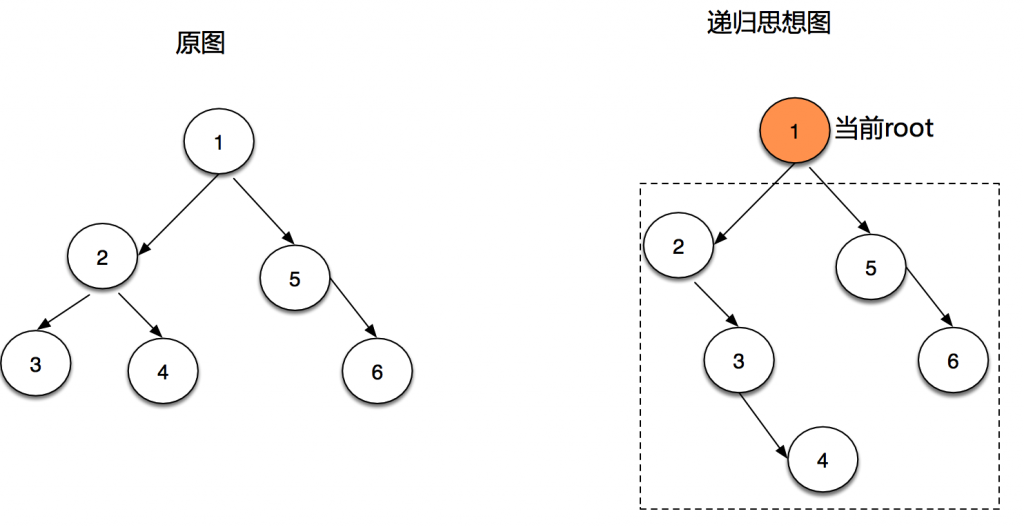
代码
|
1 2 3 4 5 6 7 8 9 10 11 12 13 14 15 16 17 18 19 20 21 22 23 24 25 26 27 28 29 30 |
class Solution { public void flatten(TreeNode root) { if(root == null){ return; } flatten(root.left); flatten(root.right); TreeNode preNode = precessor(root); // 节点操作逻辑 if(preNode!=null){ preNode.right = root.right; root.right = root.left; root.left = null; } } TreeNode precessor(TreeNode root){ root = root.left; if(root == null){ return null; } while(root.right !=null){ root = root.right; } return root; } } |
6.2 BST转双向链表
将一个 二叉搜索树 就地转化为一个 已排序的双向循环链表 。
|
1 |
输入:root = [4,2,5,1,3] |
输出

算法:
- 递归思想。
12345678910111213141516// 左边链表节点Node leftNode = treeToDoubly(root.left);// 左树最右节点Node preNode = findRightNode(leftNode);if (preNode != null) {preNode.right = root;root.left = preNode;}// 右树Node rightNode = treeToDoubly(root.right);if(rightNode!=null) {root.right = rightNode;rightNode.left = root;}
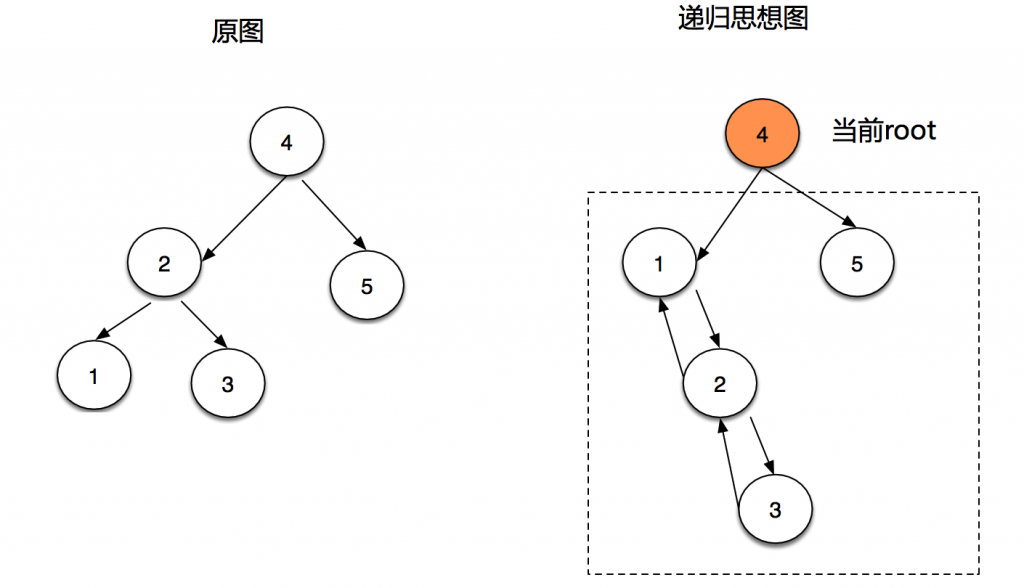
- 最后再处理 头部和尾部节点。
|
1 2 3 4 5 6 7 8 9 10 11 12 13 14 15 16 17 18 19 20 21 22 23 24 25 26 27 28 29 30 31 32 33 34 35 36 37 38 39 40 41 42 43 44 45 46 47 48 49 50 51 52 53 |
class Solution { public Node treeToDoublyList(Node root){ if(root == null){ return null; } Node head = treeToDoubly(root); // 最后处理头部和尾部节点 Node tail = findRightNode(head); head.left = tail; tail.right = head; return head ; } public Node treeToDoubly(Node root) { if (root == null) { return null; } // 左边链表节点 Node leftNode = treeToDoubly(root.left); // 左树最右节点 Node preNode = findRightNode(leftNode); if (preNode != null) { preNode.right = root; root.left = preNode; } // 右树 Node rightNode = treeToDoubly(root.right); if(rightNode!=null) { root.right = rightNode; rightNode.left = root; } if(leftNode!=null) { return leftNode; }else { return root; } } private Node findRightNode(Node root) { if (root == null) { return root; } while (root.right != null) { root = root.right; } return root; } } |





